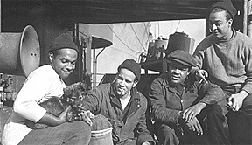Blacks from other countries often experience a major culture shock upon coming to America. They hail from lands where Blacks are the majority and hold political and social power. This is not to say that Non-American Blacks did not experience discrimination, because many of these countries were colonized by Europeans at one time. But coming to America, from either Africa or places of the African diaspora, one can be in for a rude awakening.
One such person who was subjected to a rude awakening was Hugh Mulzac. He holds the distinction of being the first Black to be captain of a ship during World War II. Stipulated Mulzac:
"Under no circumstances will I command a Jim Crow vessel."
As you may recall, the Merchant Marines during times of war or national emergency acts as an auxiliary to the military during times of war or national emergency. Hugh Mulzac commanded the Booker T. Washington, one of 18 ships named after prominent African Americans. See Ships named After Famous Black People in WWII: Liberty Ships.
Mulzac was born in the British West Indies (Union Island, St. Vincent and Grenadines) in 1886. He worked on the sea after high school, traveling on British vessels. The sailor attended Nautical School in Swansea, Wales, where he earned a mate's second in command license. During World War I he sailed as a ship's officer.
 |
| Usmm.org |
Caribbean-born Mulzac was confronted with the "barbarous customs of our northern neighbor", meaning the United States. He attempted to attend a North Carolina White church while on port of call from a Norwegian ship. Mulzac was refused entry because of his color. This incident became his first exposure to the stinging racism of America's Jim Crow South.
Mulzac later immigrated to the United States in 1918 and became a citizen. In 1920 he scored 100 percent on the US shipmaster exam. However, there was no shipmaster assignment. The belief system of the day made it difficult for a Black person to captain a ship. Being a cook or cleaning were the few options for a Negro sailor. In the meantime, he became an expert in food service.
 |
| wikipedia.org Captain Hugh Mulzac with his crew. (Mulzac is fourth from the left) |
Hugh Mulzac later served as a mate on the SS Yarmouth, a ship of Pan-Africanist Marcus Garvey's Black Starline, in 1920. He became displeased with the operations and resigned; the ambitious line went out of business in 1922. Years would go by, and Mulzac held on to his dream of being a captain of a ship. He was a founding member of the National Maritime Union in 1937. A good two decades would pass until finally Mulzac was offered his plum assignment: Captain of the Booker T. Washington during World War II. Mulzac was 56 years old.
Everything I ever stood for, fought for, dreamed of, came into focus that day. The concrete evidence of achievement gives one's striving for legitimacy, proves that the ambitions were alive, the struggle worthwhile. Being prevented for those twenty-four years from doing the work for which I was trained had robbed life of its most essential meaning. Now at least I could use my training and capabilities fully. It was like being born anew."
Hugh Mulzac had a fully integrated crew representing 18 different nationalities. He was originally assigned an all Black crew, which he refused. Protests resulted in an integrated crew. The Booker T. Washington made over 22 round trip voyages in five years. Under Mulzac the vessel carried 18,000 troops and cargo to Europe and the Pacific. He braved extremely dangerous waters. The Merchant Marines suffered a high ratio of casualty losses compared to the various branches of the military.
German submarines were sinking Merchants Marine ships at a record clip; the Booker T. Washington never lost a crewman to enemy fire. This was due largely to the navigational talents of its submarine dodging captain.
Unlike surviving Montford Marines who are in their seventies-nineties, Hugh Mulzac received limited glory. After the Allied victory he was unable to command a ship. He filled a lawsuit against the ship operators in 1948 and lost. He was also blacklisted for being a member of the labor movement at the height of McCarthyism, where groups associated with Communism were considered Un-American. Mulzac ran for NY Controllers Office and was defeated. He made his living for the next two decades in the steward's department on several shipping lines.
 |
| Usmm.org Hugh Mulzac (1886-1971) |
Hugh Mulzac did have success as a self taught painter, however. His works were on display at the Countee Cullen Library, New York City, in the year 1958. Two years later, his license and seaman's papers were finally restored by a federal court. The former captain was able to work again at age seventy-four--as a night mate. Mulzac died before Merchant Marines would win the right to receive Veteran's benefits.
Hugh Mulzac successfully helped America defeat the Axis Powers by providing his impeccable navigational skills. He made history as the first Black to command a WWII era ship, and repeatedly made the perilous journey of crossing German submarined infested oceans. He ultimately never gave up his dreams of commanding an integrated ship.
 |
| aaregistry.org Crew of the Booker T. Washington with mascot dog. |
Sources:
maraad.dot.gov
voyagetodiscovery.org
wikipedia.org
http://hubpages.com/hub/Hugh-Mulzac-First-Black-Captain-of-a-WW2-Liberty-Ship
books.google.Hidden History: Profiles of Black Americans
Notes:
African Diaspora- Countries throughout the world where people of African descent dispersed.
Marcus Garvey (1887-1940)-Jamaican political leader, publisher, journalist, entrepreneur.
McCarthyism-Named after Senator Joseph McCarthy (1908-1957). 1950s era hunt for people believed to be Communist and often without evidence.
Port of Call- A brief harbor stop where passengers are discharged.








